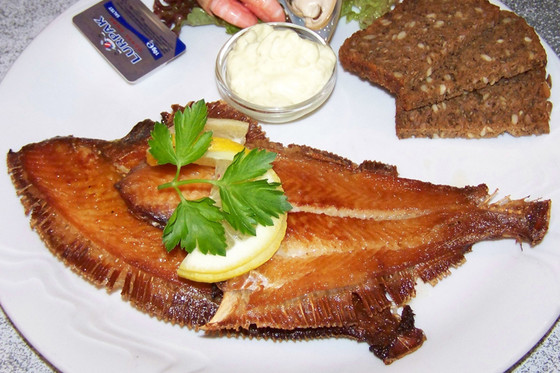Bakskuld - a wind-dried and raw fish
If one wants to come home from a visit to Jutland with ones honor intact, you have to have tasted bakskuld. Bakskuld is a skinned, salted and air dried flounder, which conventionally is eaten either raw with coffee, heated on glowing embers and wrapped in wet paper, or diluted and pan fried. The dried fish can also be smoked and is now a days on a piece of rough, homemade bread with homemade remoulade.
Tradition from Fanø and Esbjerg
The tradition of eating the dry flat fish came from the fishing towns of Esbjerg and Fanø. The name can be traced back to the beginning of the 1600s, where the so called “Ese-girls” put bait on hooks for the long line fishermen. The cords were then placed in special trays, so they were easier to carry in the boat - out on the sea to the dunes where the “Skuldere”, (a flatfish), lay. Fishermen were enterprising and sold their catch in the entire region. The dried and salted flatfish from Fanø even reached down to Hamburg under the name Riberskulle, because they were delivered by merchants from Ribe, who sold them on. Flounder now a days is known as bakskuld, maybe because the slightly timid fish was considered unsalable, so the fishermen threw it back in the tray for personal use or as a part of the payment to the “Ese-girls” - girls from the town of Esbjerg.
Fish was common food?
Especially at Fano fish was an important part of nutrition right up to modern times. In Fanø History writes local historian N.M. Kromann about the time around 1870 that: there should preferably be fish in the house throughout the year, so you never lacked anything, neither morning nor afternoon nor evening. Often the potatoes ran out at spring, and then people instead ate cured fish or fresh fish several times weekly, and often three times a day taking alternated between the different fish varieties. "Bakskulden” has thus been common food in the South Jutland in centuries.
You want to try it?
If bakskuld is not exotic enough for your palate, then you can consider one of the other Southern Jutland specialties from the menu. One possibility is “Sun-eggs”, which means boiled eggs, that is baked on salt after being rolled in it, so they get fine patterns. Sun-eggs is served with mustard, chili sauce and vinegar. But of course you can also just make a good old fashioned “Snysk”. Snysk is a typical Southern Jutland summer dish made of fresh vegetables from the garden. The Pot dish comes from the area around Flenborg and come in both thin and thick Snysk. Traditional Snysk consist of vegetables such as green and thick beans, peas, carrots, turnips, potatoes and milk boiled together and thickened and seasoned with parsley or savory. Snysk is served with fried bacon, smoked ham, pickled herring or fried eel. Bon Appetit!




